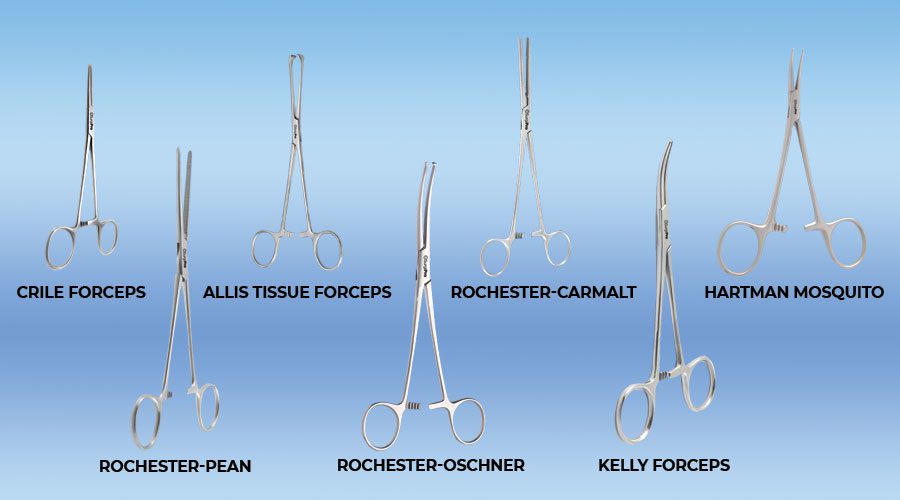
A Complete Guide for Grasping Instruments
Posted on 18th Dec 2021
Grasping Instruments
Surgical Grasping Instruments can be broadly divided into two categories:
- Ring Forceps (also called hemostat clamp, arterial forceps, hemostatic forceps and locking forceps).
- Thumb Forceps (frequently called tweezers or pinning forceps).
Ring Forceps:
Ring forceps also called hemostats or locking forceps, are an instrument for grasping, holding firmly, or exerting traction upon objects especially for delicate operations. Usually, hemostatic forceps have a locking mechanism called a ratchet, which is used for clamping. The jaws of the locking forceps gradually come together as each increment of the ratchet is employed. Locking hemostatic forceps can be known as clamps and are used to soundly maintain tissue. When they’re used to govern blood glide, they’re known as hemostats. Hemostats are normally used to compress blood vessels or different tubular systems to hinder the flow of blood or fluids.
Types of Ring Forceps:
Crile Forceps: Hemostatic Crile Forceps, also known as Crile hemostats, are amazing surgical Instruments. They have a razor-sharp blade with horizontal serrations, making them great instruments. They are available in a variety of patterns, including Curved and Straight forceps. They are used to clamp tissue or blood arteries before ligation or cauterization. They’re also employed during laparotomy procedures to dissect tissues.
Rochester-Pean: These hemostatic surgical forcep comes with fully serrated jaws. This instrument is commonly referred to as a “Big Kelly. The peans are commonly used to clamp vessels to control bleeding during surgical procedures..
Allis Tissue Forceps: These forceps are used in many surgical procedures. The Allis Tissue Forcep is a surgical instrument with sharp teeth that is used to grab and hold heavy tissues. Because Allis tissue Forceps can damage soft tissues, they are only used to remove tissue.
Rochester-Oschner Forceps: These Hemostats are used for clamping off blood vessels to prevent bleeding during procedures like orthopedic surgery. These heavy forceps designed for clamping large vessels or grasping dense tissue. These ring-handled forceps come in a variety of lengths to help with a variety of cases.
Rochester-Carmalt Forceps: these forceps are designed with jaws that have longitudinal serrations and cross-serrated tips. These hemostatic ring-handled forceps are designed to grasp major blood vessels in order to stop them from bleeding. They come with straight or curved jaws and can be utilised for a variety of procedures, including gripping an ovarian pedicle.
Kelly Forceps: These hemostats can be used to hold tissue or clamp bigger vessels. Rochester forceps and Kelly hemostats have a similar appearance. Kelly hemostats, on the other hand, have shorter serrations. Hemostats from Rochester can go a little deeper.
Hartman Mosquito Forceps: The fine, short tips of the Hartman Mosquito forceps are complemented by a serrated jaw. When the incision is shallow, Hartman Mosquito hemostats are used as hemostats for clamping small blood vessels and fine tissue dissection. They can be used to clamp small blood vessels or to hold fine sutures. The Halsted Mosquito Forceps are a lighter and longer hemostat.

Thumb Forceps
Thumb forceps used for compressing holding, grasping or manipulating body tissue in surgical procedures and handling sterile dressings. Thumb forceps are classified into two types:
Tissue forceps typically have teeth that provide a better grip on tissues while causing less tissue damage.
Types of Thumb Forceps:
- Adson Tissue Forceps: Forceps with teeth at the tip that are used to handle dense tissue, such as skin closures. These ratcheted instruments, also known as locking forceps, are used to hold tissue or objects.
- Bonn Tissue Forceps: These forceps are designed for delicate work, commonly used during ophthalmic surgery to maintain or grip certain tissues.
- Iris Forceps: Just like Bonn tissue forceps, Iris forceps are also use in ophthalmologic work.
- Foerster Tissue Forceps: The Foerster forceps are an excellent choice when a firm grip and minimal tissue trauma are required. The unique octagonal keyhole in the handle of these serrated forceps provides positional control.
